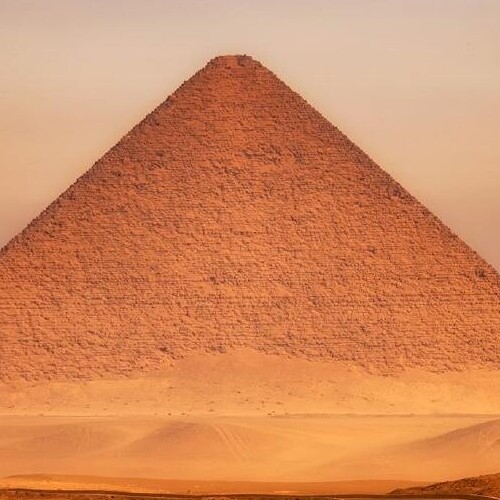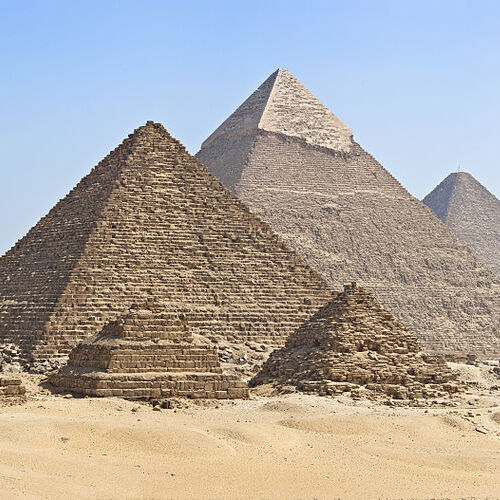No other nation in the world says ‘Welcome’ as often as the Egyptians, and every time, they mean it. While the ancient civilization of Egypt continues to amaze, contemporary Egyptians are equally remarkable.
Pyramid Of Menkaure
Menkaure's Pyramid: A Testament to Ancient Majesty
In the southwestern corner of the storied Giza Plateau, where the sands of time meet the heavens, Menkaure’s Pyramid stands tall among its legendary brethren. As a successor to his illustrious father, Khafre, Menkaure sought to immortalize his reign with a monumental pyramid, christened “Menkaure is Divine.” Amidst the grandeur of Giza, it stands as the smallest of the three pyramids, a testament to its pharaoh’s legacy.
History whispers tales of Menkaure’s untimely demise, his pyramid left incomplete. In a testament to filial piety, his son Shepseskaf took up the mantle and concluded the pyramid’s construction, employing mudbrick to seal the final chapters of this awe-inspiring edifice. As centuries unfurled, temples were added, bearing witness to the enduring mortuary cult that thrived throughout the fourth and fifth dynasties.
Menkaure’s reign, spanning approximately 18 years, is etched in stone on the pyramid’s entrance, an inscription attributed to Khaemwaset, a prince and son of the illustrious Ramesses II. It is within these mighty limestone walls that Menkaure’s legacy found a place in eternity.
Adorned with white limestone casing blocks at its pinnacle and durable pink granite below, Menkaure’s pyramid showcases meticulous craftsmanship. Intriguingly, the construction technique hints at a top-down approach, suggesting that the pyramid’s ascent from the sands was never fully realized. The modern-day entrance still offers a glimpse of the enduring granite casing blocks.
The annals of time reveal that it was during the Mamaluke era in the 12th century A.D. when a colossal gash marred the northern side of the pyramid. However, it wasn’t until 1837, when Vyse and Perring ventured inside, that the pyramid unveiled its secrets. Amidst its chambers, a basalt sarcophagus came to light, bearing the name “Menkaure.” This precious relic embarked on a fateful voyage, destined for England but lost forever in the depths of the Mediterranean Sea when its vessel, the Beatrice, succumbed to the elements.
Four meters above the plateau’s embrace, the pyramid’s northern entrance beckons. Beyond lies a labyrinthine journey through horizontal corridors, revealing an inner chamber adorned with intricately carved stone panels whose purpose remains shrouded in mystery. The antechamber, with its ever-evolving design, leaves historians pondering its original intent, perhaps a resting place.
Vyse’s exploration unearthed remnants of a wooden anthropoid coffin, bearing the name “Menkaure.” However, the skeletal remains within were of a later era, entwining the pyramid with enigmatic narratives.
Further within lies a passage leading to the burial chamber, adorned with six niches, believed to have cradled the king’s canopic jars or sacred funerary relics. The burial chamber itself is lined with pink granite, showcasing the stark simplicity of Menkaure’s resting place. Here, Vyse’s discoveries reached their zenith, as a magnificent basalt sarcophagus cradled the mortal remains of the pharaoh.
Menkaure’s queens, too, found their eternal repose near his pyramid. Three pyramids on its southern flank, often overlooked, bear testament to this. One, marked by a T-shaped substructure, originally intended for cultic purposes, became the final resting place for his queens. Mudbrick chapels adorned these satellite pyramids, offering a glimpse into the afterlife’s preparation.
On the pyramid’s eastern side, remnants of Menkaure’s mortuary temple endure, hastily constructed but displaying innovative methods of its time. Amidst its walls, fragments of royal statues emerge, each a testament to Egypt’s enduring artistry.
Beyond the pyramid’s boundaries, Menkaure’s causeway and valley temple bear the marks of time. While mudbrick supplanted limestone in the causeway’s final stages, the valley temple retained its grandeur, a testament to the reverence Shepseskaf held for his father.
Explorations since 1988, some 300 meters south of the Great Sphinx, have unearthed the Wall of the Crow, revealing a worker’s cemetery. Recent excavations orchestrated by the Egyptian Antiquities Organization seek evidence of the construction ramp and the elusive funerary boats of the king. Among the findings is a peculiar double-statue of Rameses II, sculpted from a single block of stone, a monumental mystery standing at the crossroads of history.
As the sands of time continue to reveal their secrets, Menkaure’s Pyramid stands as a beacon to Egypt’s timeless majesty, a monument to its pharaohs, and a testament to the enduring allure of the Giza Plateau.
Created On April 07, 2020
Updated On January 27, 2024
Giza Travel Guide



